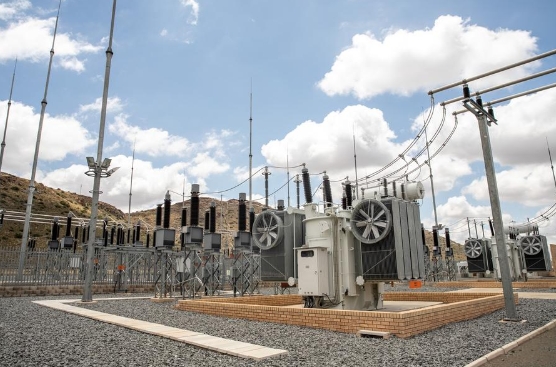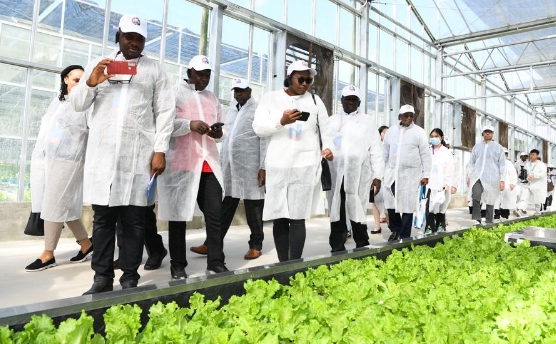China: A reliable partner in Africa's greener and greater future

Photo taken on Nov. 22, 2021 shows facilities of the De Aar wind power project invested by China's Longyuan Power and its South African partners in De Aar, South Africa. (Xinhua/Lyu Tianran)
In September 2023, China pledged at the first Africa Climate Summit that it would launch an Africa Solar Belt program to advance 100 million yuan (about 14.1 million dollars) for solar projects in regions not served by main power grids, which will help at least 50,000 families.
China-Africa cooperation can be characterized in many ways. Based on sincerity, it aims for real results, promotes amity, and proceeds from good faith. If one were to use a color to highlight this cooperation, green comes to mind.
At the very first Ministerial Conference of the Forum on China-Africa Cooperation (FOCAC) held in 2000, ministers from China and Africa emphasized the need to strengthen cooperation on the development of green energy. Since then, it has remained an important part of China-Africa cooperation, featuring in 10 cooperation plans, eight major initiatives and nine programs within the FOCAC framework.
Located in northeastern Kenya, the Garissa Solar Power Plant is the first major solar plant to tap into the country's vast solar resources and the largest grid-connected solar power plant in East and Central Africa. Designed and built by a Chinese company in conjunction with Kenya's Rural Energy Authority, the plant supplies half of the solar power generated in the country, powering 70,000 homes and offsetting about 43,000 tons of carbon emissions every year. The plant has been praised by former Kenyan President Uhuru Kenyatta as one that puts Kenya on the path of achieving green energy sufficiency and adds to Kenya's rich profile as the center of Africa's green energy transition.
In Uganda, the Chinese-built Karuma hydroelectric plant is the largest power-generating installation in the country. It can cut 3.48 million tons of carbon emissions annually, not to mention the 200 million-plus U.S. dollars in revenue it generates for the government, which is close to 0.5 percent of the country's current GDP. Together with the Isimba hydroelectric power plant also built by a Chinese company, it has doubled Uganda's total installed hydropower capacity from 764 megawatts to 1,552 megawatts, contributing to realizing the country's goal of ensuring access to secure, affordable and sustainable energy for all.
In South Africa, the De Aar Wind Farm developed by a Chinese company has an installed capacity of 244.5 megawatts. Since it began operation in 2017, the project has supplied 760 million kilowatt-hours of clean electricity annually, meeting the demand of 300,000 households while reducing 619,900 tons of carbon emissions each year.

Participants of the 2nd Forum on China-Africa Cooperation in Agriculture visit an agricultural science and technology innovation center in Sanya, south China's Hainan Province, Nov. 14, 2023. (Xinhua/Yang Guanyu)
These projects are just a few of the over 100 green energy initiatives carried out by China and Africa within the FOCAC framework, many of which have become flagship projects that turbocharge Africa's socioeconomic development and industrialization.
Such cooperation has also supported Africa's green transition drive. According to Brookings' Foresight Africa report, by 2030, Africa will have 17 cities with more than 5 million inhabitants and 90 cities with at least 1 million inhabitants. The African Development Bank predicts that Africa can more than double its industrial GDP from 751 billion dollars to 1.72 trillion dollars within the next decade.
Still, Africa is the most vulnerable continent to the adverse impacts of climate change, which can threaten to undo its development gains and cause the continent to slip into even higher levels of extreme poverty.
Therefore, it is important for Africa to build more robust and resilient green electricity-generating facilities to meet a growing electricity demand from rapid urbanization and industrialization and to reduce environmental pressures. And its partnership with China, as evidenced by the numerous solar, wind, hydro and thermal power plants running across Africa, is instrumental in this process.
China-Africa cooperation on green energy also contributes to improving the well-being of local people. In addition to large-scale projects that power cities and regions, small but beautiful programs have been rolled out to meet the electricity demands of rural communities.
In September 2023, China pledged at the first Africa Climate Summit that it would launch an Africa Solar Belt program to advance 100 million yuan (about 14.1 million dollars) for solar projects in regions not served by main power grids, which will help at least 50,000 families.
On the sidelines of last year's COP28, China announced the launch of the China-Africa Energy Innovation Accelerator Program, under which China will work with Africa to explore and apply smaller-scale innovative technologies and solutions best suited to the diversified needs of African countries in their energy transition.
Actions speak louder than words. The two-pronged approach combining large-scale power projects with small but beautiful people-centered programs has helped light up numerous African households and Africa's path to sustainable development. In real and concrete terms, China has proven itself as a reliable partner in the continent's greener and greater future.
Editor's note: Yi Xin is a Beijing-based observer of international affairs.
The views expressed in this article are those of the author's and do not necessarily reflect the positions of Xinhua News Agency.
Editor:伏娅敏
